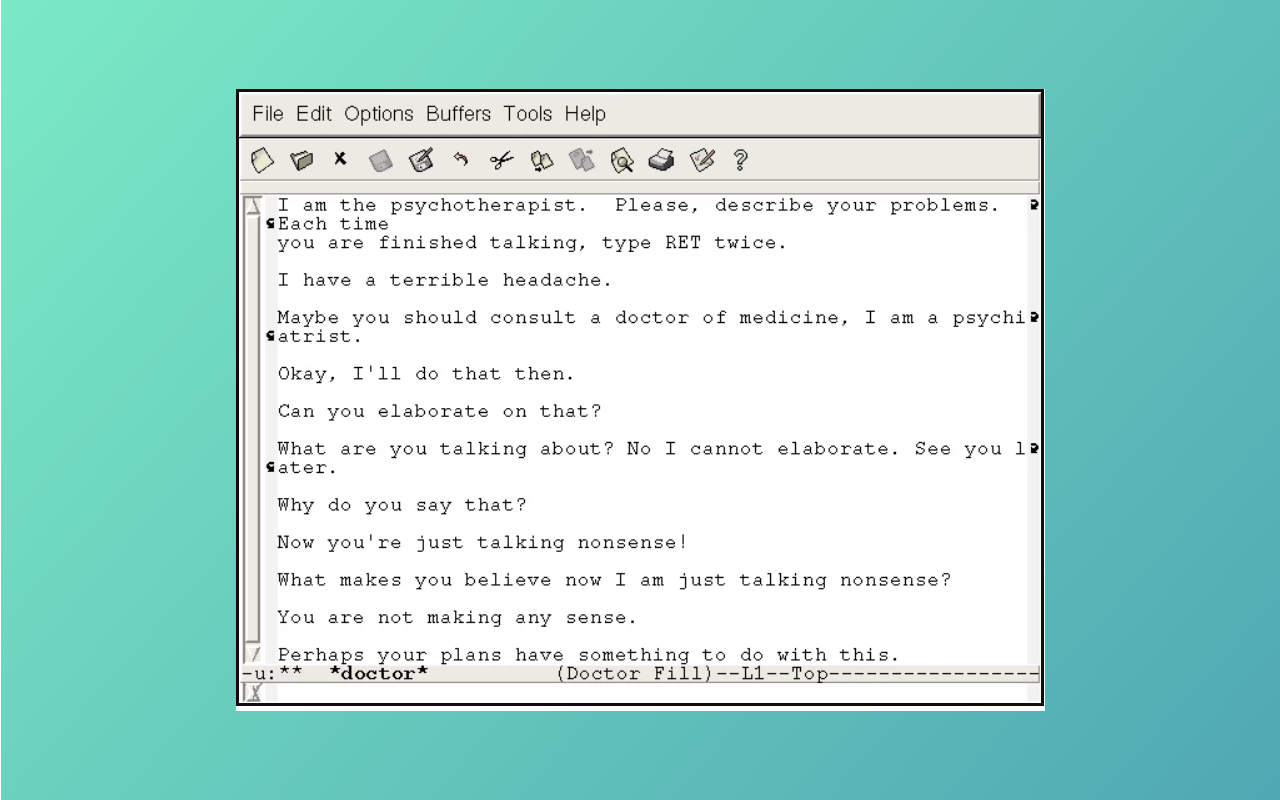What Inspired Our Name - The Original Chatbot
At Liza, we’re focusing on the use of chatbots to help usher in the consumerization of healthcare. With that, we’d like to share what exactly inspired Liza -- the ELIZA computer program.
ELIZA was an early natural language computer program created by Joseph Weizenbaum at the MIT Artificial Intelligence laboratory between 1964 and 1966 with the intention to simulate person to person communication. The program is widely considered to be the first chatbot, and had various programs scripts that allowed for a specific interaction, the most famous being the DOCTOR script.

Many of the participants of the program reported that they thought they were having a person to person contact, rather than with the computer program. This was achieved by programming ELIZA to recognize keywords and ranking them in order to provide a response that would make sense to the person in the context of the conversation. If ELIZA was not able to decipher where the conversation was leading, it would ask for the user to expand on the topic. At the time, the technology was not sophisticated enough to learn as it went along and in order to make changes to the programming, the operating script had to be updated manually with new information.
The real impact that ELIZA had was the realization that a computer program could be therapeutic. Despite knowing that they were interacting with a computer program, participants in the study actually grew attached to ELIZA. Weizenbaum has repeated that he made the observation with his secretary, stating that on several occasions, he found her in conversation with ELIZA, telling it details of her personal life. She genuinely thought the computer understood her, likening her conversation to one with a person.
We are now in an era where AI is much more advanced, and as a result, so have our bots. Chatbots like Woebot and Sense.ly’s Molly are sophisticated enough to carry conversation and even act as therapist for many patients. As we look to further the consumerization of healthcare, having 24-hour access to care will be a key component for patients. Using what we have learned from ELIZA, we can now use chatbots for simple scheduling and to even serve therapist for those with depression and anxiety.
Now in 2018, we look to ELIZA as an inspiration for Liza. By emphasizing care, access, and intelligence, we hope to help drive the consumerization of healthcare.
Evolution of Chatbots: Appointments and prescriptions,
and soon, medical professional?
By now, you have interacted with a chatbot at some point. From ordering a latte on your Starbucks app to booking a flight to Hong Kong, there are many experience that have adopted this technology. Even around the house, there are assistants like Siri and Alexa, both of which are AI driven. When done well, they are easy to use, easy to access, and often have a quicker response time than human interactions. The next evolution of this technology will be found in an industry that has long been a pain to deal with — healthcare.

In the recent past, to schedule a visit with your doctor meant calling their office and leaving a message with their assistant or on voicemail. It is a frustrating process, especially if you are experiencing complications with your health. There are now chatbots that will assist you in these moments. By identifying the type of care that is needed, the client can bypass the added cost and loss of time that visiting their primary care entails. The chatbot that Your.MD has created uses a quick question and answer portion called “Symptom Checker,” and it asks patients to answer basic questions to have a flow of information. Once there is enough information from the conversation for the algorithm to work, Your.MD leads patients to relevant articles or appropriate specialist to contact, even having the power to send your prescription to the pharmacy that you work with. For non-urgent situations, questions can be addressed with the current technology and answer database. They are developed to the point where patients have access to pharmacies, doctors, image centers, and specialists. With this technology, patients are improving their experience in situations where a physician or client services employee would once have been needed.
As chatbots become more sophisticated, they will have the ability to respond the way a human would. An example of a chatbot being utilized is the Luma Health chatbot. This particular chatbot engages using secure text messages. Gives the patient access to pharmacies, doctors, image centers, and specialists. With this technology, patients are improving their experience and there is no need for a physician or client services employee actively engaging on the other end, thus freeing their already busy schedule for in-person appointments. There are already patients who wish to reduce their visits, unable to justify the long-distance travel that might be needed to see a specialist, especially those in rural areas.
A key component to better health is patient engagement. By having consistent attention given to a patient, recovery and managing health becomes easier. Sense.ly is another company that has invested heavily in patient engagement. The San Francisco startup has created an interactive nurse, Molly, that interacts with patients on a regular basis via their smartphones. In an article on TechCrunch, the details of the app are outlined.
“The app speaks with patients empathetically[...] Conducting emotional analysis also helps Sense.ly alert health care providers when their patients may need mental health counseling, or are experiencing feelings of depression or anxiety as a side effect of certain prescribed medications or lifestyle changes.”
This continued healthcare long after a patient has left the medical office is key for many patients’ recoveries and it is developed enough to know what to recommend for them. Whether counseling, medication, or lifestyle changes, Molly can be the companion for those who need assistance managing their health.
While they will be best utilized for non-vital tasks, there are some chatbots that are developed enough to provide care. Using Woebot as an example, we can see the next evolution of the chatbot in healthcare. With mental health still stigmatized in some circles, the use of chatbots will allow those who are afraid to speak up or seek help to have a place to find the tools and information they need. By using chatbots, those who are suffering from depression will be able to monitor their activity and have the chatbot check up regularly, something that most doctors do not have the capacity to do. Whether it is a follow up conversation the day after an in-person or suggestions for self-care, a chatbot will provide interaction beyond regular office hours.
Woebot has been studied by the Stanford School of Medicine, and what they found was remarkable. They set out to determine whether or not having an automated conversation would help students with anxiety and depression. Of the participants, a large number reported having a lower depression score when compared to the group who had no interaction with Woebot. Harkening back to the days of ELIZA, some of the participants noted that they had enjoyed the use of the chatbot, citing that it was humorous and sympathetic in their conversations, and as a result, making them feel more comfortable.

The future will have find us having more interactions with AI powered chatbots, especially because most medical interactions and questions do not necessarily need a visit to the doctor. This bring down out of pocket costs for patients and reserves doctor appointment slots for those who really need care. Apps are already part of our everyday life, whether managing our calendars or tracking our diets. There will be some growing pains, but as the AI improves, you can imagine that every aspect of the healthcare experience will have some form of computer-assisted enhancement incorporated into it.
Consumerization of Healthcare - It’s Finally Here
Technology moves fast so it’s no wonder why many industries seem to fall behind. With paper forms, fax machines, and long phone queues, the healthcare industry has been due for disruption for some time. Consumers demand more personalized, accessible, transparent healthcare, and the industry must adapt to these needs. To succeed in a market that has grown used to instant answers, the proliferation of web based appointments and teleservices have been key in the consumerization of healthcare, opening the door to the use of AI powered chatbots as the technology improves and becomes more accepted by patients.

Many healthcare providers and insurers have already implemented online access for their clients, including scheduling and web based appointments. This allows patients to schedule an appointment rather than having to play phone tag with the doctor’s office. In addition to simple scheduling, the use of web based appointments has allowed patients to have a conversation with their doctor without having to visit for a check-up. There are some companies who are already making the shift in their services, as many are seeing a move from the traditional face-to-face appointment to online, webcam appointments. Kaiser Permanente has already begun to streamline their process by using teleservices and online appointments, reporting that they are seeing more patients online than in person. Their doctor can either make a diagnosis, write a prescription, or make a referral for a specialist all online. At the Dreamforce conference, Kaiser revealed that 52% of their total visits were done with their teleservice program, and of that 52%, 80% of those who used it were satisfied with the video feature. As the client base becomes more comfortable with the technology, they may see an even more drastic increase in use.
As AI improves, chatbots can be used for more than just scheduling out appointments for patients. While having a web based appointment is helpful, it still requires time for both the patient and the doctor to meet online. With improvements in AI and chatbots ability to interact with patients, doctors can focus on in-person appointments. Services such as Teladoc and Sense.ly’s Molly are poised to disrupt traditional care by allowing patients to access instant medical counseling. By using speech recognition to triage patients to the appropriate level of care. Ultimately, the goal is for the AI to be developed enough to decide whether the person should go to the emergency room, schedule an appointment, speak to a healthcare professional over the phone, or access self-help information. Patients no longer have to visit their doctor to receive treatment for common illnesses like the flu or food poisoning, all while having a channel to communicate with their doctor for more important or ongoing issues. In addition, if the chatbot can make recommendations based on the symptoms that the client is describing, the visit to a primary care physician can be bypassed and a referral to the appropriate specialist can be made.

Prior to the rise of automated systems like chatbots, the steps to see a specialist was rather inconvenient. A primary care physician acted as the gatekeeper, requiring an appointment with them prior to seeing the respective specialist. With chatbots, rather than making several trips to a doctor, a chatbot can triage patients. Those who have simple inquiries can be addressed online, with the chatbot making recommendations on home remedies. With some escalation, those who have more pressing matters can be dealt with by a doctor.
The marketing is evolving and health care can no longer ignore its demands. Patients are becoming more tech savvy, so why not use savviness to cut costs, save on time, and make communication easier for both sides? Opening the door for more exchange in information between doctor and patient will benefit everyone - particularly patient outcomes and quality of care!